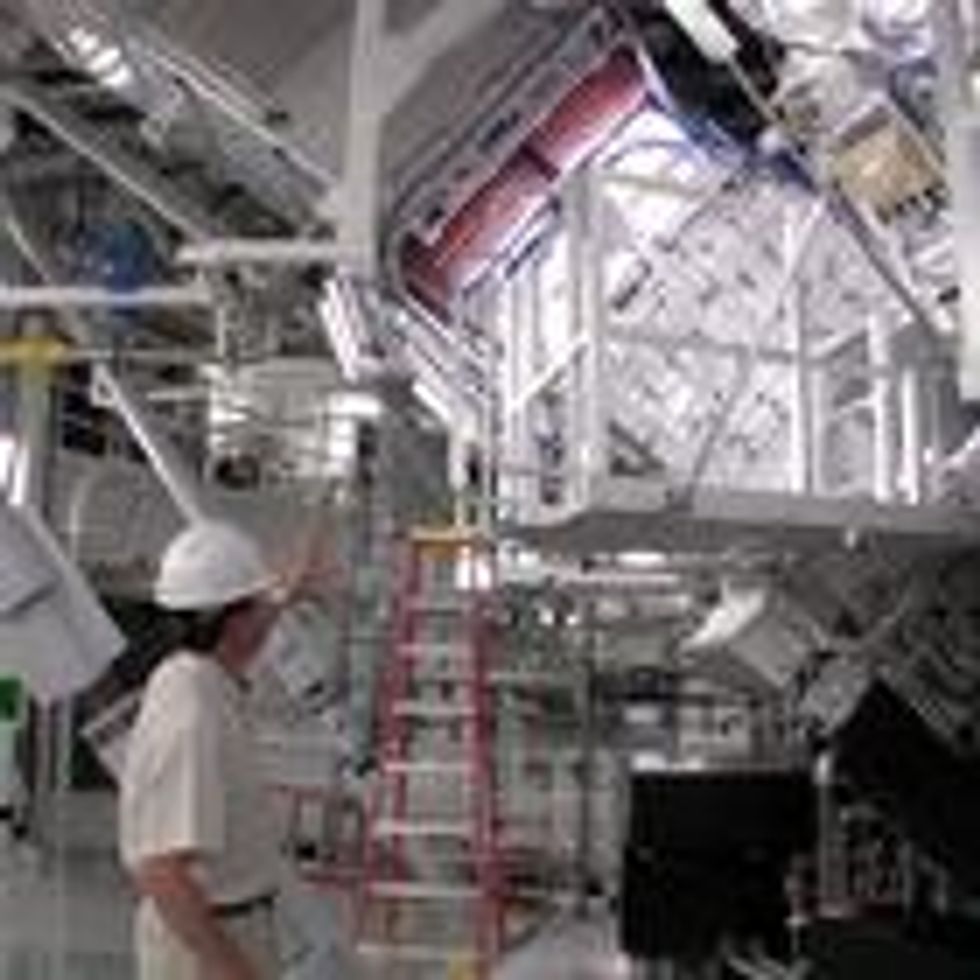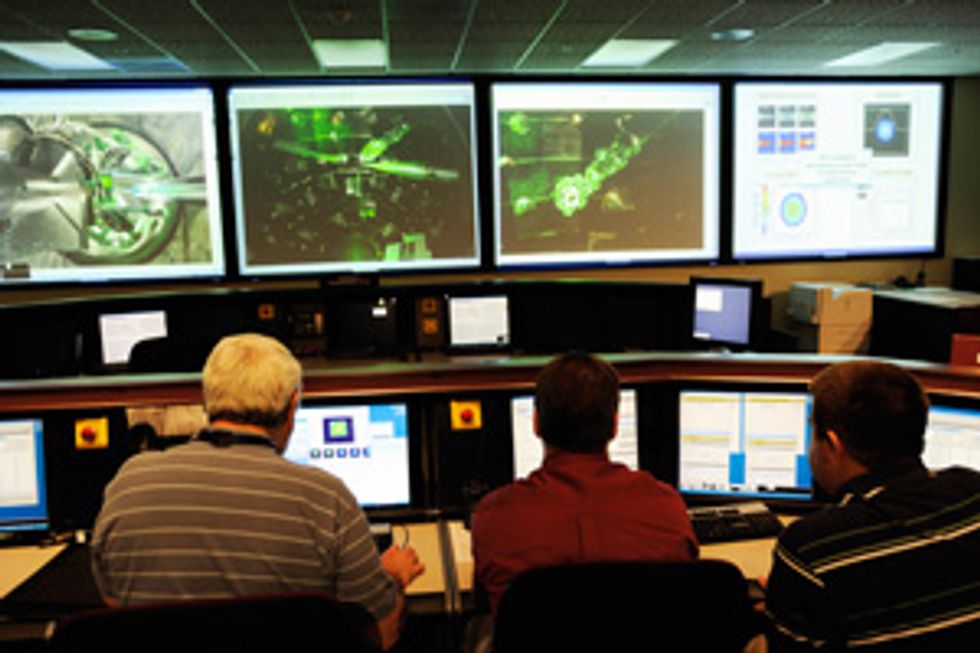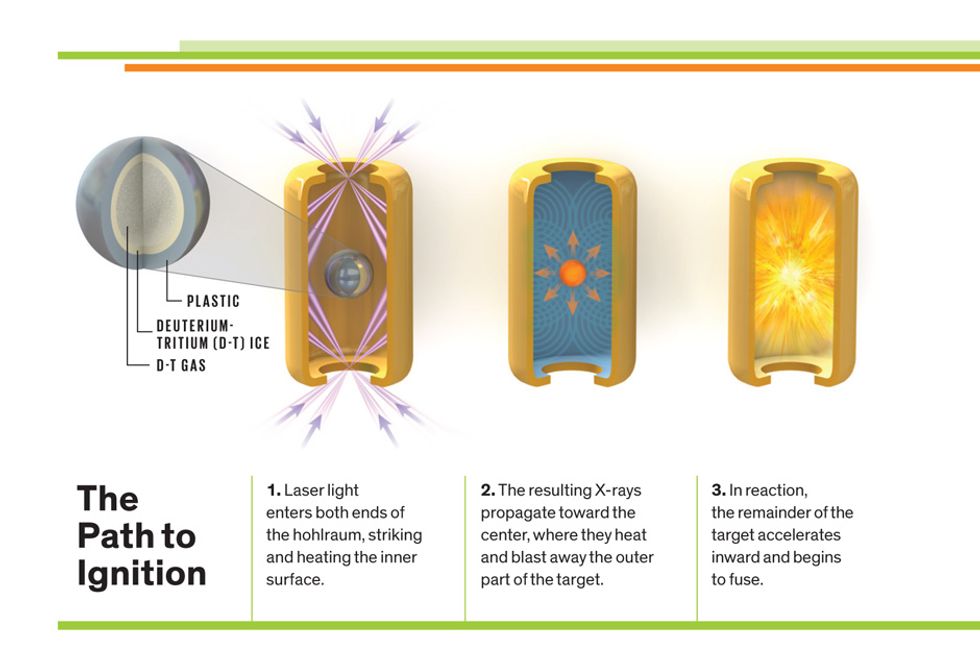Laser Fusion’s Brightest Hope
The National Ignition Facility houses the world’s most powerful laser. Is it enough to ignite a fusion revolution?
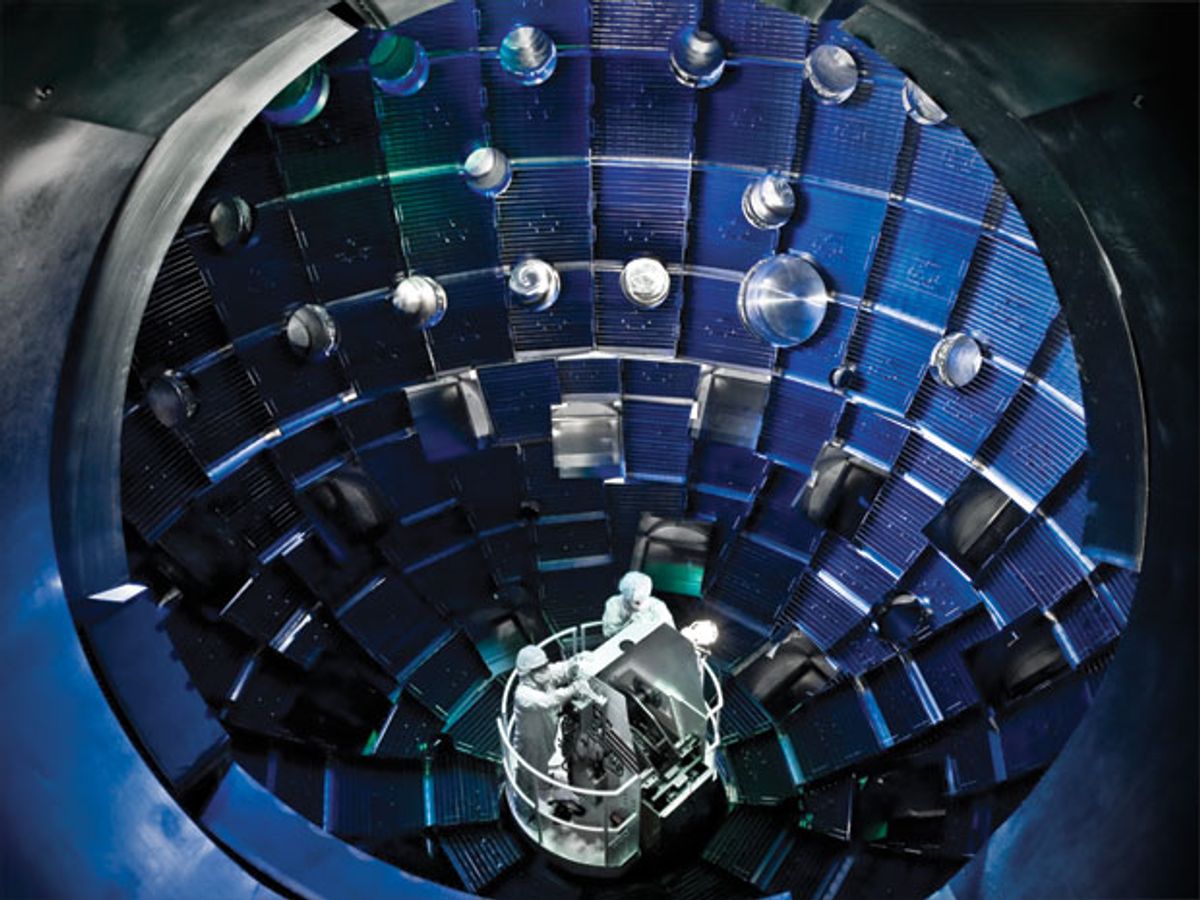
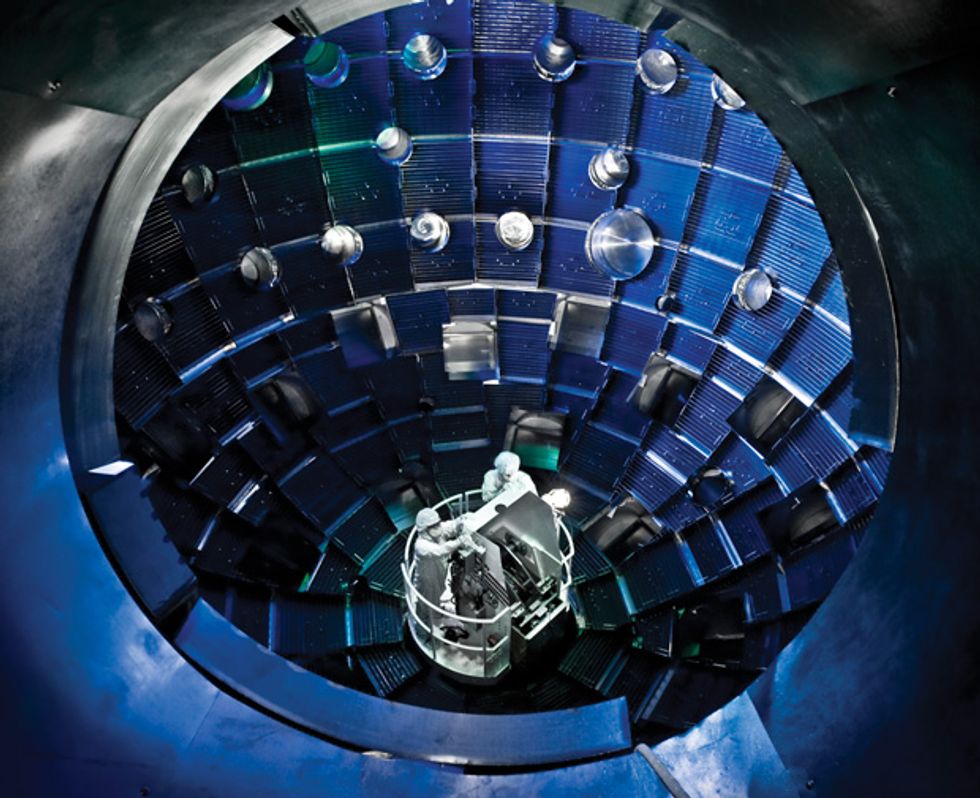
When the world’s most powerful laser zaps a target, it’s eerily silent. If you’re close enough to know the exact moment the system fires, chances are you’re standing in a darkened control room, watching a silent countdown. The only hint that something has occurred is a timer that hits zero and immediately starts counting up again. But hidden from view is an experiment of staggering proportions and precision: 192 laser beams streaming through halls that span the length of football fields, steadily gaining in strength before they finally converge within millimeters of one another, triggering the implosion of a peppercorn-size capsule.
Here at the Lawrence Livermore National Laboratory, a U.S. national security laboratory tucked amid vineyards and undulating grassy hills about an hour east of San Francisco, the lasers of the National Ignition Facility (NIF) have already created the intense pressures and temperatures needed to get atoms of hydrogen to fuse. But NIF is trying to achieve a far more challenging goal, one that countless researchers have sought for decades. NIF’s aim is not just fusion but fusion’s equivalent of a chain reaction, a self-sustaining “burn” capable of producing more energy than is needed to get the process started in the first place.
So far, this feat—called ignition—has been accomplished only in a relatively crude way, inside nuclear weapons, where the energy released by splitting atoms is used to trigger a fusion explosion. NIF is designed to bring about ignition on a smaller scale. Doing so could help stave off the need for future nuclear weapons tests, supporters say, and could inch humanity closer to the long-held dream of nearly limitless and clean commercial fusion power.
But it hasn’t all been smooth going: NIF’s past year has been a peculiar mix of triumph and defeat. In July, after years of construction delays and daunting technical hurdles, and a little more than three years after the facility’s formal dedication, NIF’s engineers finally pushed the lasers to their design specifications. In a handful of microseconds, they showed they could deliver more than 1.8 megajoules of energy in a laser shot that packs some 500 terawatts of power, about 1000 times as much power as the United States consumes, on average, at any given moment.
When NIF was conceived, that was thought to be more than enough power and energy to achieve ignition. But it didn’t happen. A 30 September deadline for ignition established by NIF’s funding agency, the U.S. Department of Energy’s National Nuclear Security Administration (NNSA), came and went. Now, expectations have been significantly scaled back. In a report [PDF] sent to the U.S. Congress in December, the NNSA said that it is “too early to assess whether or not ignition can be achieved at the National Ignition Facility.”
Critics of NIF seized on this uncertain conclusion as further evidence that the facility—which saw its construction costs triple from initial estimates to US $3.5 billion—should never have been built at all. They allege that NIF isn’t likely to achieve ignition and that even if it manages to do so, the feat is unlikely to be of much benefit to society. NIF officials reply that the facility is performing cutting-edge science for the benefit of all humankind and that it has already made a significant contribution to our understanding of the basic physics of nuclear weapons. When NIF achieves ignition, they say, it will mark a turning point in the 60-year-old quest to harness fusion for peaceful purposes. But as the delays pile up, sorting out what exactly to believe might be almost as difficult as the quest itself.
Harnessing the process that powers the stars has been the intent of many different kinds of projects over the years. But the two most well-funded approaches have been magnetic confinement and inertial confinement. The leading example of the magnetic approach is the ITER project, a $20 billion experiment currently under construction in southern France, which will use magnetic fields to confine and heat a plasma. NIF’s inertial approach, on the other hand, contains its plasma by blasting away the outer layer of a target in order to force the remaining matter inward, in the process creating the temperatures and pressures needed for fusion.
ITER, which is currently slated to come on line in 2020, is unambiguous and highly specific about its intent: to advance fusion as an energy source—a high-yield and largely pollutant-free replacement for fossil fuels. NIF has also embraced that energy goal, but within a larger, less specific context that is heavy on defense-related research.
During a lunchtime interview at Livermore in August, NIF’s director, Edward Moses, outlined a vision for a power plant based on NIF’s approach to fusion. NIF currently can fire a laser at a precisely placed stationary target every 12 hours or so. A power plant could potentially be economical if it could be designed to fire much faster—“pop, pop, pop,” Moses says, gesturing over bits of a sandwich—so that it can zap a stream of dropping fuel pellets at a rate of 15 per second.
Nothing like this scheme has ever been accomplished, even on an experimental basis. Nevertheless, it is eminently feasible, Moses insists. All that’s needed is for NIF to light the way with the initial demonstration of ignition. “People are going to think about the future differently once this works,” Moses says.
If NIF does blaze a trail toward commercial fusion power generation, it will be all the more noteworthy because NIF’s primary purpose is not power generation but rather national defense. The idea for the facility emerged in the early 1990s, around the same time that the United States was preparing to put a halt to the underground testing of nuclear weapons. The test moratorium, initially signed by President George H.W. Bush in 1992, put limits on the country’s ability to assess weapons performance. This left the United States with a stockpile of roughly 14 000 nuclear warheads. Some two-thirds of those weapons have since been decommissioned, but the others must be maintained and periodically assessed.
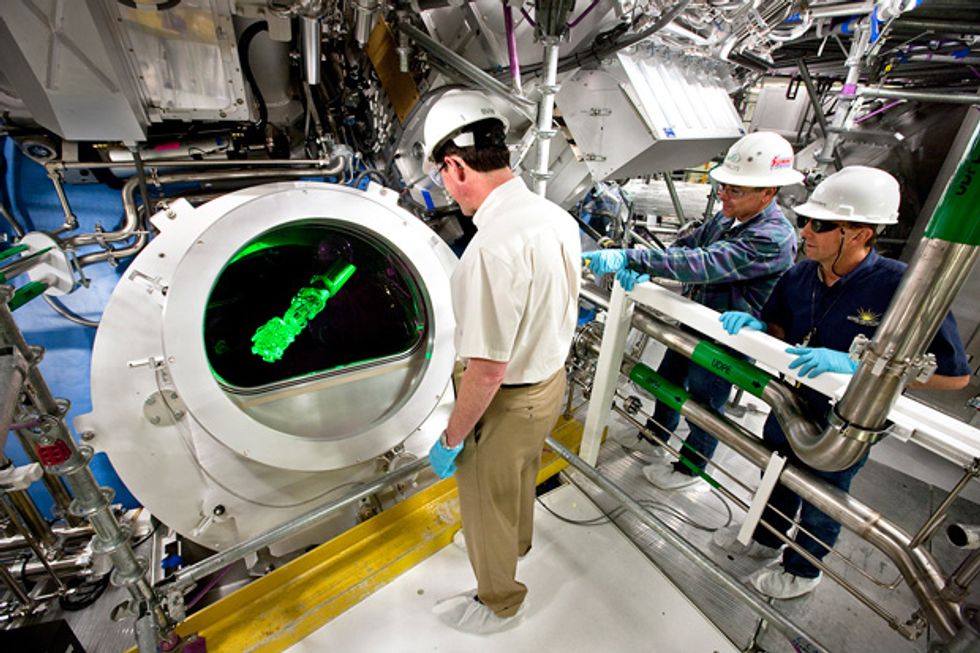
To do this, the U.S. Department of Energy devised a program called science-based stockpile stewardship, to better understand the physics of nuclear weapons and to assess the effects of aging on the nuclear arsenal. NIF is the flagship facility in this program, which includes materials and fusion experiments at two other national laboratories, as well as substantial computational clout. This year, Livermore’s new 16-petaflops Sequoia supercomputer, which held the title of world’s fastest for a few months in 2012, is to be commissioned for classified weapons-simulation work. The output of this research program is supposed to support the NNSA’s “life extension” effort, which focuses on examining and upgrading aging nuclear weapons to ensure that they are still safe and can be detonated reliably for another 30 years or so.
In the absence of nuclear testing, experiments like NIF are important, says Marvin Adams, a professor of nuclear engineering at Texas A&M and chair of the weapons science review committee at Los Alamos National Laboratory, in New Mexico. Weapon materials degrade, and safety and environmental regulations introduced over the past four or five decades have made it extraordinarily difficult to reconstitute the ability to make weapons components exactly as they were made during the Cold War, Adams says.
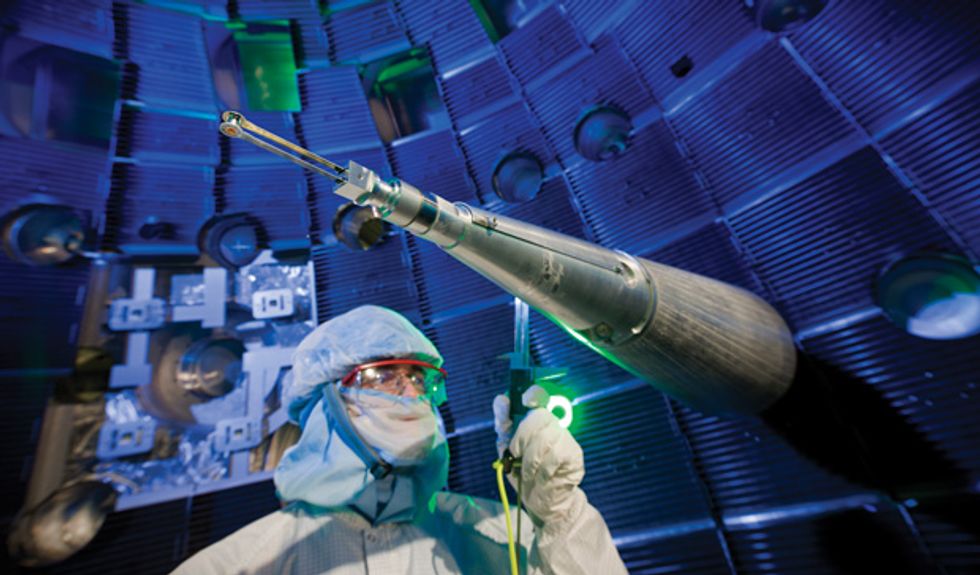
What’s more, there are still a number of outstanding questions when it comes to performance. During the years of underground testing, engineers saw anomalies and surprises in test results; in some cases, Adams says, devices that were supposed to undergo a critical stage of fusion didn’t, and others didn’t release as much energy as simulations predicted they would. “We know our codes are not perfect,” Adams says. NIF officials say that improving those codes with results from the facility’s experiments could help stockpile caretakers understand the impact of potential changes.
But how exactly will those results help maintain the stockpile? Not surprisingly, scientists and officials affiliated closely with NIF generally decline to give much detail, citing the need to keep the information confidential for national security reasons. “Once we get specific, we get classified,” Adams says.
There are two ways ignition comes into play in a modern nuclear weapon. The first stage of a warhead, the primary, consists of a hollow sphere made of plutonium or uranium that is filled with a gas made of two isotopes of hydrogen—deuterium and tritium. When high explosives placed around the sphere are triggered, the blast compresses and compacts the shell, setting off a fission chain reaction of splitting atoms. The process sends neutrons and heat into the gas-filled center of the compacting shell, triggering fusion of the gas. This fusion step, called boost, releases neutrons that stream out through the shell, splitting yet more atoms and releasing enough heat in the form of X-rays to set off the warhead’s “secondary.” This stage consists of a ball made of a solid mix of lightweight atoms—typically lithium and hydrogen—that then fuse to create most of the energy released when a warhead explodes.
NIF officials say the facility will help study and maintain aging weapons in two key ways: first, by improving simulations of the early stages of ignition and the physics of a self-propagating fusion burn; and second, by performing “nonignition” tests on materials, such as plutonium, that are currently present in weapons as well as materials that could be used to replace aging components. These tests are used to examine how well such materials transport X-rays, resist deformation, and behave under pressures and temperatures that can be achieved only at NIF.
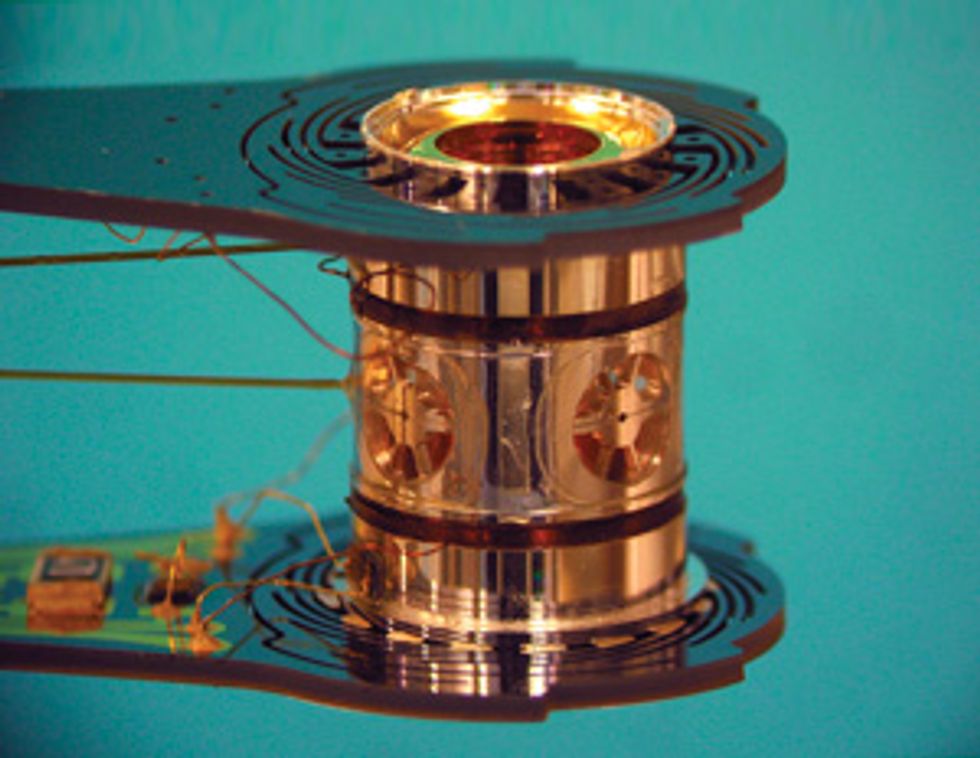
But NIF’s relationship to stockpile stewardship is far from uncontroversial. Some physicists say the link between warhead performance and the fusion of tiny, delicate targets is tenuous at best. The energy scales in a nuclear weapon are far different from those NIF can produce, and the physical processes that set off the boost phase are too different to draw a helpful link, says physicist Richard Garwin, a member of the government advisory group JASON and one of the designers of the first hydrogen bomb. “[NIF] has no relevance at all to primaries. It doesn’t do a good job of mimicking secondaries,” Garwin says in an interview. “It validates the codes in regions that are not relevant to nuclear weapons.”
Robert Hirsch, an energy consultant who directed fusion energy research at the Atomic Energy Commission in the 1970s, when laser-fusion research began ramping up, is impressed by the facility but also has reservations. “[NIF is] a great instrument, and they’ve done tremendous things to get it to operate,” he says. “Is the cost benefit worth it? That’s a different question.” He has some doubts about NIF’s defense justifications. “The answers seem a little bit fluffy in my opinion,” Hirsch asserts. “It’s not clear how well those arguments would stand up to serious scrutiny.”
NIF’s defenders point out that the facility has already made a significant contribution to stockpile stewardship (more on that below). They add that the facility performs another vital role by attracting talented people to the weapons community. Without interesting experiments to work on, Hirsch says, maintaining the stockpile would be a dull, largely “janitorial” job. But whether the facility can make any headway on some of the most interesting physics questions—and get humanity closer to fusion power—will all come down to whether NIF can live up to its middle name.
The path to ignition starts in a single room containing three small, ytterbium-doped optical fibers. These compact fiber lasers generate the pulses that will ultimately bombard the target capsule, but only after being amplified 4000 trillion times in successive stages as they pass through a massive series of optics. The main amplifiers are a series of 3072 individual meter-length glass slabs, stored high up in two long laser halls. These slabs are doped with neodymium atoms that can be excited by flash lamps just before a beam arrives, triggering the emission of yet more photons.
The optics must be carefully protected from dust. At NIF’s light levels, even minor atomic flaws in the glass can absorb enough energy to melt and fracture the surrounding material. These fractures can focus the light in unintended ways, creating intense hot spots in a beam that can create even more damage as the light propagates down the line of optics.
To minimize this sort of destruction, the amplifiers and other laser sections can be accessed only through a portable clean room or a specialized box that can form a tight seal. The laboratory has also built a small industry around damage mitigation. After a laser shot, engineers can use a telescope in the target chamber to look back through every line of optics for damage; each defect gets a number. They then use blue LEDs to program liquid-crystal-based screens through which beams pass before amplification. These screens can be made to have any arbitrary pattern of transparent and opaque areas, creating dark spots in a beam in order to circumvent damaged areas down the line. When too many defects accumulate, the engineers remove the damaged component and send it to another building, where the surface is re-treated and carbon dioxide lasers are used to etch out damage, leaving behind optically neutral conical pits. Nowadays, up to 40 pieces of optics, mostly the target-chamber focus lenses and debris shields—protective screens between the target chamber and the rest of the optical line—are pulled and sent away to be refurbished each week.
NIF conducts several different types of experiments with these lasers. Some are focused on compressing or irradiating particular targets related to the nuclear stockpile or else pure materials like diamond for basic materials science. Others are tailored toward illuminating a particular bit of physics related to ignition. When the facility conducts an ignition shot, however, it uses a very specific kind of pellet: a 2-millimeter-wide hollow sphere (so far, most have been plastic) filled with a gas consisting of equal parts deuterium and tritium. These two neutron-heavy isotopes of hydrogen are the easiest to fuse. The pellet is cooled to 18 degrees above absolute zero, which causes the hydrogen closest to the outside of the sphere to form a roughly 100-micrometer layer of ice that is some 10 times as dense as the gaseous fuel at the center.
There are no lasers in a nuclear weapon, so NIF is pursuing ignition using an alternate approach, called indirect drive. Instead of converging directly onto the fuel pellet, NIF’s lasers shine through two holes at either end of a hollow container, called a hohlraum. The lasers heat the walls of this hohlraum, creating X-rays that in turn irradiate a pellet, which sits suspended between two trampoline-like skins made of ultrathin polymer.
When X-rays hit the pellet, they blast away the plastic coating on the outside of the fuel, and the resulting implosion drives the deuterium and tritium inward, creating a ball of fuel that’s about 1/35 its original diameter and 1/40 000 its original volume. If this reaction happens fast enough, a hot, high-pressure spot forms in the center of the fuel. This spot can reach 100 million kelvins, more than six times the temperature at the center of the sun. Deuterium and tritium atoms fuse to create streams of neutrons and helium atoms. As these helium atoms zoom outward, they collide with the frozen fuel, which is already compressed to a density some 100 times that of lead. If conditions are right, the heat from these colliding particles will be enough to fuse many more atoms and create ignition, sending more energy out than was put into the hohlraum to begin with.
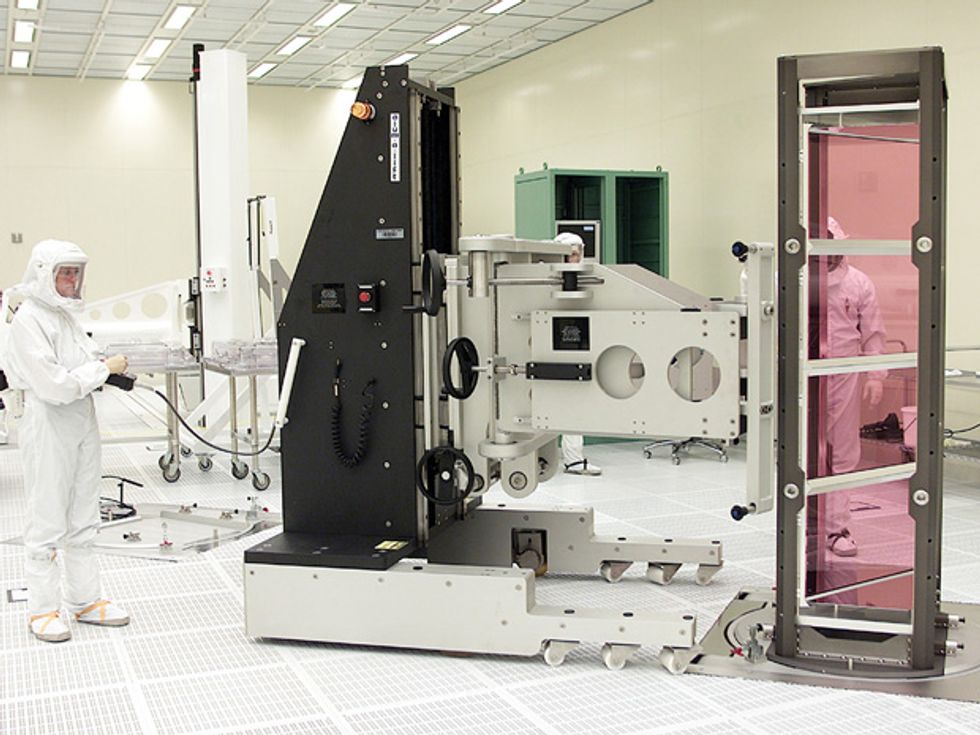
So far, however, Mother Nature has not played along. Some four years before NIF started experiments, NIF’s scientists, and the project’s managers at the NNSA, expected that ignition might be achievable in just a few years. “Back in 2005, there were some concerns due to budget issues,” says Christopher Deeney, director of the NNSA’s Office of Inertial Confinement Fusion. So the NNSA came up with a plan, called the National Ignition Campaign, at the request of Congress, that proposed a series of milestones for the facility. The NNSA’s plan called for ignition by the end of the campaign this past September. But that timetable was based on early simulations of the lasers and the target, and it now seems to have been overly optimistic (Deeney calls it “success oriented”). The problem, he says, is that “the codes do not seem to be reproducing exactly what we’re seeing in experiments.”
The discrepancy between the two is basically a mystery at this point. The simulations have to account for a lot of complex physics, of course. And it doesn’t take much for an ignition shot to miss its mark. If the deuterium-tritium ice layer is imploded too quickly or too unevenly, it can crack and cause high-temperature material to mix with the colder fuel, driving down the pressure of the reaction and dampening the fusion. And the most infinitesimal asymmetry in the X-rays can cause the fuel to squash less like a sphere and more like a pancake, which reduces how much of the kinetic energy of the fuel ultimately translates into compression.
“This isn’t something nature wants to give you easily,” says John Lindl. I’m meeting with NIF’s chief scientist late one afternoon in December, a few months after the National Ignition Campaign’s close. One of the key difficulties, he explains, comes down to laser interactions with gases and material sloughed off the inside of the hohlraum. “The problem is, this isn’t a vacuum—there’s a lot of stuff in here,” he says, sketching out the cylinder on my pad. The lasers “pass through one another, and they pass through one another in the presence of a high-temperature, pretty high density gas.” Density fluctuations in the gas can cause beams to diffract or pass energy from one to another. The NIF team’s current theory is that, in part due to all of these interactions, the lasers are not hitting their marks exactly, creating an asymmetry in the X-rays.
Lindl says that the team had been getting “tantalizing hints” from fairly crude X-ray images down the length of the hohlraum that the implosion might not be symmetric. In October, they set up an X-ray camera in the target chamber capable of taking 2-D snapshots during compression, including a couple during the 0.1 nanoseconds that the fuel is under peak compression. Instead of appearing as a perfect circle, the outer edge of the compressed fuel looked more corrugated—a bit like a four-leaf clover. Fixing that coarse asymmetry by updating the codes and further fine-tuning the beam targeting, Lindl says, could go a long way toward pushing the team closer to ignition. But he stops short of saying that it will be sufficient.
Like other fusion researchers, who think in terms of decades, Lindl bristles at the suggestion that a “grand challenge” like ignition could be accomplished on a strict deadline specified years in advance. “I think the progress has been remarkable,” he declares, citing advances the team has made in fabricating targets and ramping up the laser power.
I ask him about one parameter that is often cited as evidence of slow going at NIF: the experimental ignition threshold factor (ITFX), a number that acts more or less as a stand-in for pressure. An ITFX of 1 is thought to match what would be needed to break even, with as much energy in as energy out. After starting out with an ITFX of 0.001 two years ago, for the last year or so NIF has been stalled at an ITFX of 0.1. But Lindl says that this simple number hides some notable progress: The team has found ways to get to the same pressures while driving the fuel inward more slowly. That accomplishment might help them get to ignition by reducing the chance of cracking the ice layer. “We’re awfully close” to ignition, Lindl says. “You don’t change horses at this point.”
Lindl and his colleagues will get more time to prove that ignition is possible. In the wake of the National Ignition Campaign, the plan that set a 30 September deadline for ignition, the NNSA hopes to scale back the number of shots dedicated specifically to ignition from 80 percent to 40 percent, in part to help clear a backlog of stockpile stewardship shots. The NNSA plans to give NIF three years to pursue ignition before assessing the facility’s prospects again.
Researchers say there is plenty to be excited about. The facility has only started to ramp up shots for basic research, which scientists hope could help illuminate complex questions related to stellar physics and planetary interiors, among other topics.
And a number of people say that NIF has already accomplished something big. Charles Verdon, principal deputy of Livermore’s Weapons and Complex Integration Directorate, says the facility has helped clear up an unresolved question about energy balance, the way that X-rays from the primary, fission-dominated component of the nuclear warhead are carried to the fusion-dominated secondary. For half a century, Verdon says, weapon designers had to introduce a “fudge factor” to account for discrepancies between the expected performance and the data coming from underground tests.
“The fudge factor’s been around since the first nuclear explosions way back in the ’50s, when I was a kid and I’d watch the sky light up over L.A. from the explosions out in Nevada,” says Robert Byer, a physicist at Stanford University who led a recent review of the facility. “It’s amazing,” he says. “NIF solved a problem that’s crucial for our weapons systems understanding.”
But when it comes to ignition, the picture is a little blurry. Those in the know simultaneously play up NIF’s importance to stockpile stewardship and downplay the consequences should NIF fail to achieve an energy-surplus ignition. Many say the U.S. stewardship effort is already quite healthy, buoyed by hundreds of historic nuclear tests and few changes to designs since then. “Not having ignition in the laboratory is not a showstopper, but it does take off some future options,” says NNSA’s Deeney. “It would impose some limits on how we would handle change [to nuclear weapons] in the future.”
Texas A&M’s Adams urges the public not to read too much into the shortcomings of NIF’s simulations. “If you look at what’s going on at NIF in the stretch to try to reach ignition, those are tremendous excursions from previous experiments,” he explains. “We’ve never had access to this much laser energy before, never tried to do anything like it.”
“I’m not going to tell you that the stockpile would fall apart if we didn’t have NIF or that it will fall apart if we don’t get ignition, because I don’t believe it will,” Adams adds. “I think we will maintain a safe, secure, and effective stockpile, but our choices will become more limited.”
NIF’s impact on fusion power is also difficult to evaluate. Livermore has heavily publicized its scheme for a power plant based on NIF, called Laser Inertial Fusion Energy (LIFE). But even if NIF does reach ignition, critics point out, it will likely do so just barely. And that means that the agenda for a commercial power plant may not advance much. Analysis suggests that to be practical a fusion power plant would need to produce 50 times as much energy as went into the operation of the facility. Fuel pellets would have to be produced in vast numbers for about 25 cents each; Deeney reckons their current cost is more than $10 000 per pellet.
There are also materials issues to contend with: The neutrons created in fusion can degrade materials such as steel and render them radioactive. LIFE’s approach is to use conventional steel that can be swapped out every few years; that may not be the best approach for a commercial plant.
But all of that is years away, at least. And if NIF fails to reach ignition, this particular approach will likely remain so. When it comes to fusion power, says Stanford’s Byer, “most people throw their hands in the air and say it will never happen.” Then again, he says, defense research can produce great and unexpected things: Without nuclear weapons, he notes, we might never have gotten conventional nuclear power plants. He could have added nuclear medicine and high-speed computing to the list. Although things may look dark now, for all we know the path to a brighter future might just be paved with lasers—192 of them.
This article originally appeared in print as "Star Power."
